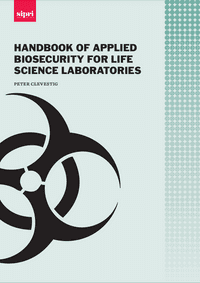Handbook of Applied Biosecurity for Life Science Laboratories
[Handbook of Applied Biosecurity]
This handbook seeks to engage scientists, laboratory employees, and students in laboratory biosecurity and also provides practical advice regarding the secure handling, management, and storage of biological materials. This book seeks to raise awareness of biosecurity issues in the lab and how the life sciences can be maliciously used.
SUMMARY
This handbook offers practical advice for securing potentially hazardous biological materials or sensitive information technology in the laboratory against unauthorized access, loss, theft, misuse, or intentional release. It also aims to engage scientists, laboratory employees, and life science students on the issue of laboratory biosecurity. Section 1 describes the purpose of the handbook. Section 2 of the handbook introduces the basic components of laboratory biosecurity, including biosecurity risk assessment, employee accountability, material control, information security, transport security, and physical security. These biosecurity components are relevant to all laboratory employees. Section 3 may be more relevant to laboratory managers and other people in positions of authority because it focuses on the laboratory supervisor’s role in safeguarding laboratory assets. This supervisory role involves reporting security breaches, managing personnel, and planning responses to breaches or incidents.
Stockholm International Peace Research Institute (SIPRI) was founded in 1966 to provide data, analysis, and recommendations on issues related to global security. The author is Dr. Peter Celevestig of the SIPRI Arms Control and Nonproliferation Program. Dr. Peter Celevestig is a virologist with experience working in the laboratories of Karolinska Institute (KI) and serving on the KI laboratories’ Biosafety Committee. SIPRI and the author identified a gap in current biosecurity publications and published this guide to address that gap. They observed that guidance on biosecurity was often presented at the national or international level and any discussion of biosecurity in the laboratory arose only when the issue was directly related to biosafety. This handbook may be useful for any laboratory employee or manager seeking to understand how biosecurity is relevant in a laboratory setting. As of September 2021, this document is only available in English and has no scheduled updates.


..png)
